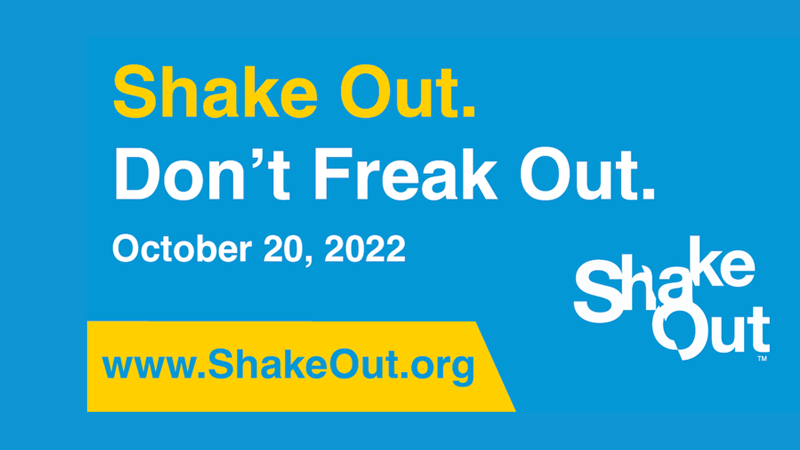Get Ready to Shake Out: Earthquake 101

Courtesy of ShakeOut.org
October 20 is International Shakeout Day in 2022. Have you ever wondered what causes earthquakes? Or about the techniques used to predict their frequency? What about how to protect yourself during an earthquake?
Civil and environmental engineering professor Jonathan Stewart of the UCLA Samueli School of Engineering answered these questions and more on a recent episode of the “I Don’t Know About That with Jim Jefferies” podcast.
“So you feel that initial shaking, what you should do is ‘drop, cover, and hold on,'” Jonathan Stewart said.
Stewart’s research interests include geotechnical engineering, earthquake engineering and engineering seismology. He has studied what happens to infrastructure during earthquakes around the world and is a co-director of the multidisciplinary, multi-university Natural Hazards Risk and Resiliency Research Center and a member of the UC Seismic Advisory Board. In 2020, Stewart was awarded the Erskine Fellowship from the University of Canterbury in Christchurch, New Zealand, where he collaborated with researchers on studies pertaining to earthquake ground motion and soil liquefaction.
Following are excerpts from Stewart’s interview on the show with modifications for brevity and clarity.
Q: Why do earthquakes happen?
A: Plate tectonics are the underlying cause of earthquakes. Essentially, the earth is still a relatively young planet, and it’s hot on the interior and that heat is dissipating. There’s a process called convection where the heat comes from the interior toward the outside of the planet — the surface of the planet — and then it starts traveling horizontally. That hot material cools as it’s sort of dragging the surface of the earth (referred to as a “plate”) horizontally. These plates are moving in different directions on the surface of the earth and when you have two plates moving relative to each other, that’s a plate boundary and you get concentrations of earthquakes at that boundary.
Q: What should you do to protect yourself in an earthquake?
A: If you’re talking about during the earthquake itself, so you feel that initial shaking, what you should do is “drop, cover, and hold on.” “Drop” means you get down on your knees. “Cover” means you take one hand and put it behind your head to sort of shield yourself if something falls, so it hits your forearm and not your head. “Hold on” is where you take your other hand and, if you can, grab onto a table leg, or something like that, to keep yourself steady.
Q: Can earthquakes be predicted with any accuracy?
A: When people say “predicted,” sometimes what they are asking for is a forecast like what would be provided for the weather. We can’t do that; it is not possible to predict “There’s going to be an earthquake Friday” or something of that sort. What we can do is identify the locations of faults that are likely to produce earthquakes, evaluate the approximate rates and sizes of future earthquakes, and predict the ground shaking and effects of those events. These predictions are for long-time horizons, and are expressed as a probability of an event or a certain level of shaking being exceeded in a time frame like 50 years or so.
Q: What does it mean for the ground to be liquefied?
A: Liquefaction is when soil loses strength during an earthquake. It occurs when a sandy soil with shallow groundwater experiences strong shaking. The pore pressure in the water goes up and the strength goes down, and then the ground can experience large deformations and structures founded on the ground can topple over because of the loss in bearing capacity. One of the most famous recent examples of this is Christchurch, New Zealand in 2011, which was severely damaged by widespread liquefaction.
Q: What is the “Ring of Fire”?
A: The “Ring of Fire” is around the perimeter of the Pacific Plate where relative plate-to-plate motions occur. California is part of that perimeter, with Los Angeles actually being located on the Pacific side of the plate boundary (the North American plate is to the east). In California, the Pacific Plate is moving gradually to the northwest and as it does, strains accumulate along the plate boundary, which are released in the form of earthquakes. In other parts of the Ring of Fire, volcanic eruptions and great earthquakes occur as a result of the Pacific Plate subducting beneath the continent, for example in the Pacific Northwest, Alaska, Japan and so on.
Q: Would any of the effects of climate change impact earthquakes the way it does hurricanes, drought, etc.?
A: Climate change doesn’t affect the generation of earthquakes. It impacts many other types of natural disasters, but not earthquakes.
Riley de Jong contributed to this story.
